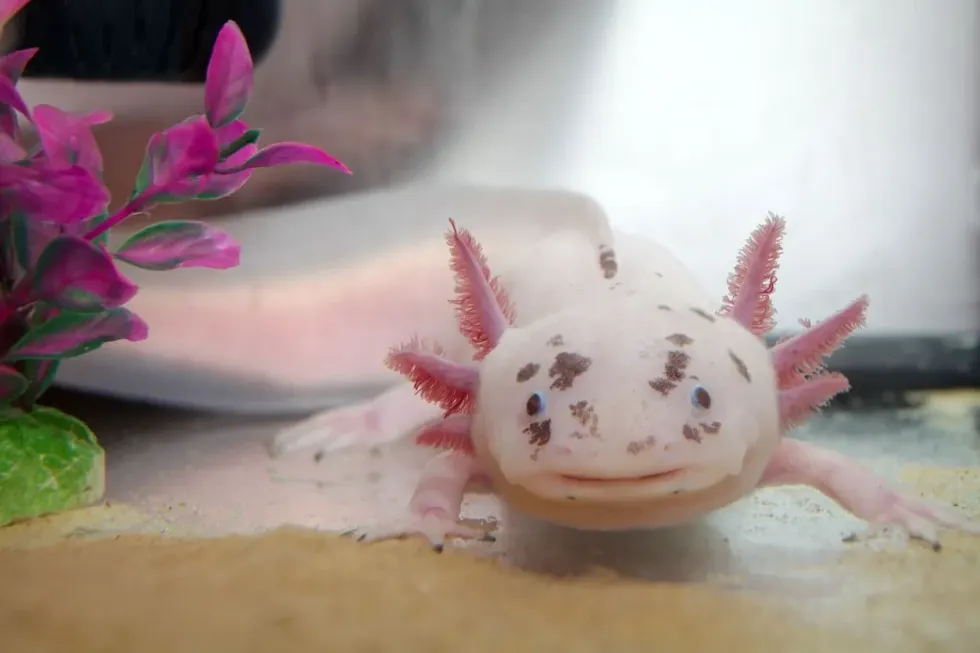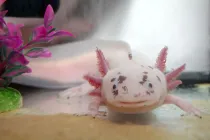Are you ready to know about one of the most interesting amphibians that hail from Mexico? Yes, we are talking about the axolotl, which has almost become an imaginary character among people.
However, these animals are real, and scientists have been interested in them for a long time. The axolotls are also known as the 'Mexican walking fish', but they are actually nothing like fish. They are amphibians native to the freshwater Lakes Xochimilco and Chalco, close to Mexico City.
They have a juvenile body due to a process called neoteny. The fish-like body of this salamander helps them to navigate the waters and the ground as they mostly dwell at the bottom of lakes.
Scientists have mostly been interested in their ability to regenerate. Axolotls are mysterious for their ability to grow back their limbs, and it has made them a part of the Aztec mythology.
Axolotls have a simple diet that includes fish, worms, crustaceans, and other small animals found on the bottoms of the lakes. Interestingly axolotls have also been part of the human diet.
Currently, they are very popular as exotic pets. The wild species are also noted as being 'Critically Endangered' in their native habitat. Doesn't it sound interesting?
Keep reading to find out more about axolotls. Check out the marine toad and the bonito fish to know more about animals.
Axolotl Interesting Facts
What type of animal is an axolotl?
An axolotl is a type of salamander endemic to Mexico and is also known as the 'Mexican walking fish'.
What class of animal does an axolotl belong to?
Axolotls belong to the class Amphibia as they are amphibians having both gills and lungs. They belong to the genus Ambystoma.
How many Axolotl are there in the world?
It is believed that less than 1000 individual Axolotl or fewer are left in the wild. As Lake Chalco doesn't exist anymore, the species is restricted to Lake Xochimilco.
Where does an Axolotl live?
Axolotls are native to Mexico and live in the freshwater lake of Xochimilco. As axolotls have been a part of the pet trade, they are also found in human homes.
What is an Axolotl's habitat?
Axolotls like to live in freshwater, and they are one of the amphibians that live mostly underwater. The axolotl population is mainly found in Lake Xochimilco.
The temperature of the lake doesn't normally rise above 68 °F (20 °C), making it perfect for the species. Similar care has to be taken while setting up a tank for keeping axolotls as a pet. The effective wild habitat of axolotls is still a mystery as they are endemic to only one lake.
Who do Axolotls live with?
Not much is known about the living patterns of axolotls. However, in the wild, they do live with others of their species. In captivity, multiple axolotls can stay in the same tank, but the owner should provide them ample amount of water.
In Lake Xochimilco, the axolotls are also said to cohabit with Tiger salamanders though the species do not breed with each other. Axolotls have long been a favorite pet for many because of their dragon-like look. So, many of these salamanders have made it into people's homes.
How long does a Axolotl live?
The axolotl's lifespan is said to be 10 - 15 years in the wild. They may have a longer lifespan in captivity. Some people think that axolotls are immortal, but that isn't true. They do have the special power to regenerate their limbs up to five times.
Regeneration plays a big role in the life of an axolotl. It is a primary reason for them being a hot favorite research topic for scientists.
They have been studied for a long time, and it has been seen that they can regenerate their limbs and internal organs due to the presence of the c-Fos protein. An axolotl can even regenerate new cells to heal brain injuries.
How do they reproduce?
Axolotls have a unique way of mating that includes the pair dancing together. In the wild, the breeding season of axolotls lasts from March to June. But, in captivity, these aquatic salamanders can breed twice or more each year.
A female axolotl can have 300 - 1,000+ eggs at a time. It takes two weeks for the eggs to hatch so that baby axolotls can come out. They are often left on their own after birth.
Axolotls in the wild seldom grow up. They follow a life cycle called 'neoteny' where the wild axolotls can reach sexual maturity without going through metamorphosis like other amphibians.
The limbs and other body parts of an axolotl remain almost the same as that of their larval stage. It might be their way of survival to sustain in times of scarce food sources.
As research on axolotls is abundant, it has been noted that metamorphosis can take place in axolotls if they are given a shot of iodine. The salamanders suddenly grow up to look more like a Tiger salamander, and they can survive on land as well.
It is seldom seen in the wild, though some pet owners have tried to bring the metamorphosis on their own. However, it is best to leave them alone.
What is their conservation status?
According to the International Union for Conservation of Nature or IUCN Red List, the axolotl is currently a critically endangered species. This is true for the wild axolotls, who are mainly restricted to the channels of Lake Xochimilco.
They are having a hard time surviving in the wild as several invasive species like the African tilapia and the Asian carp have started feed on them. Along with that, the constant urban sprawl of Mexico City has led to water pollution that is deadly for the salamanders.
Their aquatic habitat has been ruined in the wild.
However, the population of axolotl salamanders is prolific when it comes to the exotic pet market. These animals are sold under different exotic names for people to buy them.
Axolotl Fun Facts
What do Axolotls look like?

Axolotl (Ambystoma mexicanum) is also known as the Mexican walking fish. They aren't really fish species as they are actually amphibians that live in an aquatic environment.
The salamanders do have gills like that of a fish, and they can be seen protruding from the sides of their head. Gills are the main way for them to breathe, although they do have rudimentary lungs, which may grow stronger if they have a successful metamorphosis.
Axolotls follow neoteny, so the matured forms look similar to that of the larval stage.
The limbs of these salamanders have long digits, but they aren't well-formed. You may identify a male axolotl by looking at their cloacae (posterior opening) which is swollen.
Male axolotls also tend to be larger compared to females. So most axolotls depend on swimming around the water. Axolotls are found in various colors.
The ones that are found in the wild have a darker color that is either black or brown. They may also have golden spots on their body.
However, four pigmentation variants of axolotl colors have been found in them. It includes the pale pink Axolotls that are popular in the exotic pet market.
The mutated colors are leucistic, albino, xanthic, and melanoid. These color variants are usually created due to breeding and aren't found naturally in their native wild habitat of Mexico. The wild salamander may have a very limited ability to change their colors to camouflage with the habitat of the lake.
Axolotls also come with different eye colors. The animals aren't completely blind, but they do not have good eyesight.
How cute are they?
Axolotls are especially cute as they retain the look of their childhood. The aquatic salamander also has a smiling face which makes them extra cute.
How do they communicate?
Not much is known about the communication forms of axolotls. However, during the mating season, the axolotls are able to understand visual as well as chemical cues. They may also have the power to detect electric fields.
How big is an Axolotl?
The usual size of an axolotl is 6 in - 18 in (15 cm - 45 cm). Female axolotls are generally smaller than male axolotls. They have a similar size to the Mexican Tiger salamanders.
How fast can an Axolotl run?
Axolotls are not able to run because they lack well-formed limbs. However, their average swimming speed can be noted as 10 mph or 16 km/hr.
How much does an Axolotl weigh?
The average weight of an axolotl can be anywhere around 2.11 oz - 8 oz (60 g - 226 g).
What are their male and female names of the species?
There are no specific names for the male and female of the species.
What would you call a baby Axolotl?
A baby Axolotl is usually known as a 'tadpole' or 'larva.'
What do they eat?
Axolotls are carnivorous animals that sustain themselves on small fish, crustaceans, insects, worms. In captivity or as a pet, axolotls can eat things that are readily available like bloodworms and earthworms. Rather than chewing their food, the axolotls swallow and gulp down their food.
Are they dangerous?
No, axolotls aren't dangerous to humans. The animals are quite delicate and humans have also eaten them as a delicacy for a long time.
Would they make a good pet?
The status of axolotls as pets is debatable. The cute axolotl has caught the attention of humans for a long time, and they have been domesticated.
But, most of the domestic axolotls are there due to breeding. They have been part of research programs for a long time as scientists have been trying to study more about their regeneration.
So, as long as someone isn't threatening the wild population of the 'Critically endangered' axolotls, they can definitely keep them as pets.
However, one needs to give them a good diet and the appropriate habitat so that they can have a good life. You must know that axolotls aren't able to reciprocate the feelings of humans, so they might not act in a friendly manner.
To give an axolotl a comfortable home, some things need to be done. They should be housed in a big aquarium or tank, and the water should be changed regularly.
The tank should contain 11-US-gallon or up to 40 liters of water for a single axolotl. Six inches or 15 cm of water depth should be maintained in the tanks.
Rather than creating a gravel substrate in the aquarium, you may try to use sand that is softer and wouldn't cause digestive obstructions for the axolotls.
Make sure to have enough food for the axolotls, and their diet should be rich in protein. Contact a vet before you bring an axolotl to your home as they can be sensitive creatures.
Did you know...
Axolotls that are found in the channels of Mexico city are regarded as descendants of the Mexican Tiger salamander. The larvae of both animals look almost the same and even have similar gills.
The new 50-peso banknote of Mexico will sport an axolotl.
Can you hold an axolotl?
Yes, you can definitely hold an axolotl. To avoid their slippery skin it is best to wear gloves before handling these animals.
How to pronounce axolotl?
The axolotl pronunciation is ACK-suh-LAH-tuhl in English. The world is derived from the Nahuatl language that originates from the Aztecs. The meaning of the word may stand for 'water dog'. However, the name is also said to be derived from the Aztec God, Xolotl.
Here at Kidadl, we have carefully created lots of interesting family-friendly animal facts for everyone to discover! Learn more about some other amphibians including the pool frog and the caecilian.
You can even occupy yourself at home by drawing one on our axolotl coloring pages.










